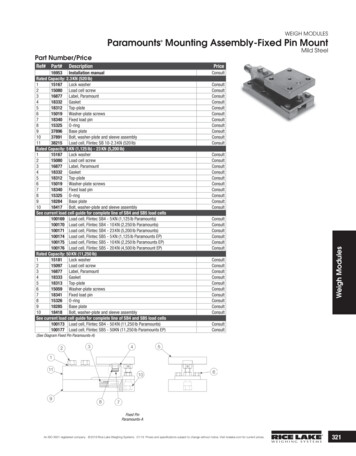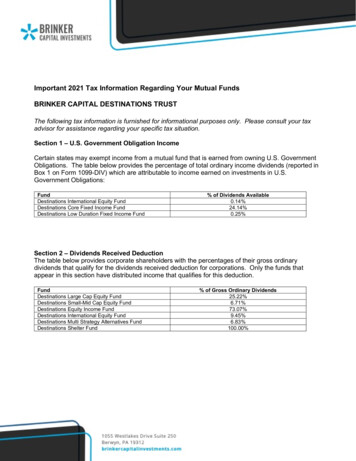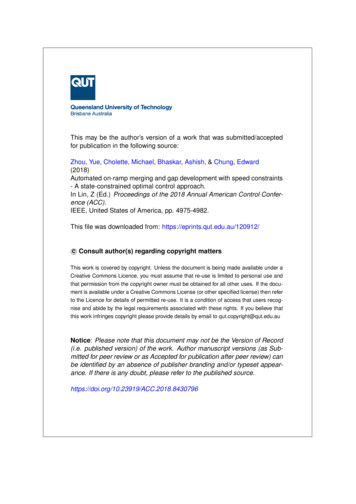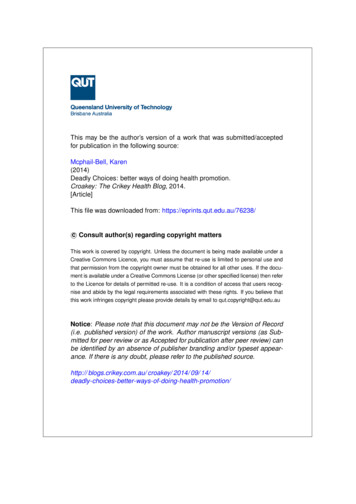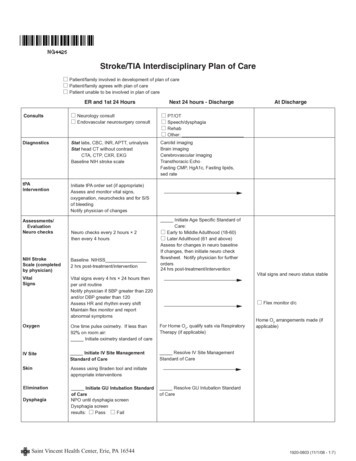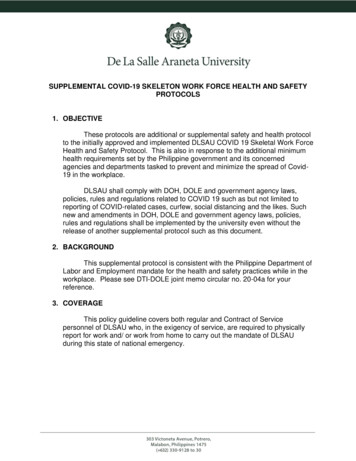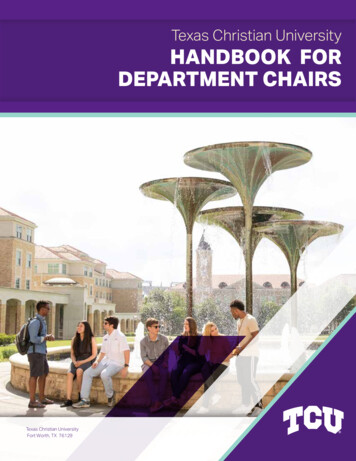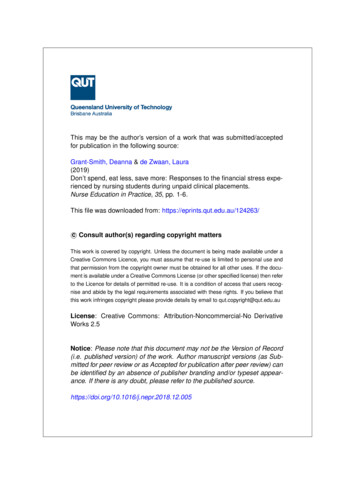
Transcription
This may be the author’s version of a work that was submitted/acceptedfor publication in the following source:Grant-Smith, Deanna & de Zwaan, Laura(2019)Don’t spend, eat less, save more: Responses to the financial stress experienced by nursing students during unpaid clinical placements.Nurse Education in Practice, 35, pp. 1-6.This file was downloaded from: https://eprints.qut.edu.au/124263/c Consult author(s) regarding copyright mattersThis work is covered by copyright. Unless the document is being made available under aCreative Commons Licence, you must assume that re-use is limited to personal use andthat permission from the copyright owner must be obtained for all other uses. If the document is available under a Creative Commons License (or other specified license) then referto the Licence for details of permitted re-use. It is a condition of access that users recognise and abide by the legal requirements associated with these rights. If you believe thatthis work infringes copyright please provide details by email to qut.copyright@qut.edu.auLicense: Creative Commons: Attribution-Noncommercial-No DerivativeWorks 2.5Notice: Please note that this document may not be the Version of Record(i.e. published version) of the work. Author manuscript versions (as Submitted for peer review or as Accepted for publication after peer review) canbe identified by an absence of publisher branding and/or typeset appearance. If there is any doubt, please refer to the published source.https://doi.org/10.1016/j.nepr.2018.12.005
This may be the author’s version of a work that was submitted/acceptedfor publication in the following source:Grant-Smith, Deanna & de Zwaan, Laura(2019)Don’t spend, eat less, save more: Responses to the financial stress experienced by nursing students during unpaid clinical placements.Nurse Education in Practice, 35, pp. 1-6.This file was downloaded from: https://eprints.qut.edu.au/124263/c Consult author(s) regarding copyright mattersThis work is covered by copyright. Unless the document is being made available under aCreative Commons Licence, you must assume that re-use is limited to personal use andthat permission from the copyright owner must be obtained for all other uses. If the document is available under a Creative Commons License (or other specified license) then referto the Licence for details of permitted re-use. It is a condition of access that users recognise and abide by the legal requirements associated with these rights. If you believe thatthis work infringes copyright please provide details by email to qut.copyright@qut.edu.auLicense: Creative Commons: Attribution-Noncommercial-No DerivativeWorks 2.5Notice: Please note that this document may not be the Version of Record(i.e. published version) of the work. Author manuscript versions (as Submitted for peer review or as Accepted for publication after peer review) canbe identified by an absence of publisher branding and/or typeset appearance. If there is any doubt, please refer to the published source.https://doi.org/10.1016/j.nepr.2018.12.005
Don’t spend, eat less, save more: Responses to the financial stressexperienced by nursing students during unpaid clinical placementsDeanna Grant-Smith*QUT Business School, Queensland University of Technology2 George Street, GPO Box 2434, Brisbane, QLD 4001, Australiadeanna.grantsmith@qut.edu.auLaura de ZwaanGriffith Business School, Griffith UniversityParklands Dr, Southport, QLD 4215, Australial.dezwaan@griffith.edu.au*Corresponding authorAcknowledgements: The authors acknowledge the contributions of Dr Jenna Gillett-Swanand Dr Renee Chapman in the design and conduct of the broader study on which this researchis based. The support of Dr Ricky Tunney and Katie Theobald in distributing the survey is alsogratefully acknowledged.Funding source: This work was financially supported by the National Centre for StudentEquity in Higher Education.Abstract: Using an online survey, this study explored the impact of participation in unpaidclinical placements on the financial wellbeing of 160 nursing students attending an Australianuniversity. The research found that the majority of respondents struggle financially duringclinical placements, yet are financially adequate or secure outside of semester or during normalperiods of study. Increased transport costs and loss of income are the most significant financialstressors during this time, with additional meals, work-appropriate clothing, purchasingadditional resources and materials, and childcare costs other causes of financial stress. Moststudents used savings, budgeting, borrowing, and changed expenditure patterns to cope with thefinancial impact of unpaid placement. These findings have important implications for theability of students to successfully complete their nursing degree and draw into question theequity of unpaid clinical placements as a formal degree requirement. However, whileparticipation in unpaid clinical placements can impact financial well-being in the short term,participation does have the potential to increase the financial resilience of students over time, asstudents learn and grow from these experiences. To achieve this, however, greater attentionmust be placed on the financial support and personal finance education available for nursingstudents.Highlights Nursing students experience considerable financial stress during unpaid placement Financial stress is worse for nursing students with caring responsibilities Regardless of familial or employment circumstances, additional financial assistance andsupport are required by many nursing students to support their placement participation. More support is required to support nursing student financial wellbeing during placement Universities should improve the process of assigning placements and consider offeringplacements part-time, outside of semester and during normal working hours1
Keywords: personal finance; clinical placement; financial stress; financial resilienceDon’t spend, eat less, save more: Responses to the financial stressexperienced by nursing students during unpaid clinical placementsThe completion of periods of practice learning involving the direct care of patients is a requisite forattaining a nursing degree qualification in many countries (ANMAC, 2012; NMBI, 2016; NCNZ,2017; NMC, 2018). Clinical placements typically require nursing students to complete an intensiveblock of unpaid workplace learning, which can include weekend and evening work. For example,under the requirements of the Australian Nursing and Midwifery Accreditation Council (2012)studying a nursing degree (registered nurse) requires the completion of a minimum of 800 hours ofworkplace experience, not including simulation activities. The purpose of these clinical placements isto “enable safe and competent nursing practice by program completion” (ANMAC, 2012, p.13).While the pedagogical and developmental importance of clinical placements is well documented(Gale et al., 2016; Papastavrou et al., 2016) there has been an increasing focus on research whichattends to addressing student stress within the clinical learning environment (Budden et al., 2017;Chernomas and Shapiro, 2013; Crary, 2013; Graham et al., 2016; Grobecker, 2016; Moscaritolo,2009; Turner and Lander McCarthy, 2017). However, despite this important recognition of the needto address student nurse wellbeing in a placement context (Gillett-Swan and Grant-Smith, 2018; Suenet al., 2016), the potential impact of financial stress on nursing students as a result of participation hasbeen comparably under-researched.The move away from paying nursing students a salary while developing clinical skills (Timminsand Kaliszer, 2002; Glasper, 2016) combined with a lack of financial support and increasinguniversity fees (Hall, 2010; Twycross, 2016) has seen increasing numbers of nursing students relyingon income from in-semester employment to cover both study and day-to-day expenses (Devlin et al.,2008; Wray and McCall, 2007). Participation in clinical placement typically prevents students fromcontinuing their paid employment for the duration, which can result in significant financial stress. Asa result, increasing numbers of nursing students are experiencing stress during clinical placement dueto financial difficulties (Graham et al., 2016) and additional expenses (Ralph et al., 2009) such asincreased transport, clothing, and childcare costs (Grant-Smith et al., 2018; Grant-Smith and GillettSwan, 2017).Students’ financial circumstances and concerns about finances have the potential to negativelyimpact their emotional and physical health and general wellbeing (Bemel et al., 2016; Britt et al.,2016; Deasy et al., 2014; Heckman et al., 2014; Watson et al., 2015). Financial hardship cannegatively impact academic performance (Joo et al., 2008; Northern et al., 2010), and the quality of2
the placement learning experience can be substantially compromised due to student financial stress(Johnstone et al., 2016; Collins et al., 2008). Indeed, the impact that financial strain can have onstudent participation in placement, and their life beyond placement, is well documented (Grant-Smithet al., 2017; Lomax-Smith et al., 2011; Wray and McCall, 2007). For example, Andrews and Chong(2011) found that students who indicated they were struggling financially, or who reported havingadequate finances, also demonstrated more psychological distress, stress, anxiety, and depression thanthose who reported secure financial circumstances. Further, student financial hardship is a knownsource of stress and anxiety for tertiary students (Creedon, 2015; Ross et al., 1999) and a commoncause of attrition (Schofield et al., 2009).This paper considers the financial impacts of clinical placement from the perspective ofundergraduate nursing students in a large Australian university. In particular, it highlights thefinancial hardships and stress created or magnified as a consequence of undertaking a clinicalplacement and the financial coping strategies students employ to manage these. The paper concludesby reflecting on approaches that universities and accrediting bodies may consider to reduce thefinancial stresses of participation on nursing students.MethodConsistent with prior research in the area of student experiences of placement (e.g., Kanno andKoesk, 2010) an online survey was used to gather data on perceptions and experiences of placementof students from a large Australian university. The survey included a mix of open and scaledquestions. Basic demographic questions were also included to provide context for responses. Of thefive hundred and fifty-two (552) students who completed the Qualtrics survey to a satisfactory levelto be included in the analysis, more than one-third were enrolled in a nursing qualification (37%,n 206). This paper focuses on the respondents undertaking a Nursing and Midwifery Board ofAustralia accredited program of study to become a registered nurse (Bachelor of Nursing). Thisdegree requires students to undertake at least 800 hours of work experience including a four-weekfull-time clinical placement prior to the commencement of the final year of studies. The researchproject received ethics approval from the university in which the researchers are based. Studentparticipation was voluntary and anonymous.After data cleaning, there were 160 complete responses to the survey. The sample demographicsof these respondents are presented in Table 1. Consistent with nursing enrolments and the broadernursing workforce (HealthWorkforce Australia, 2014) the majority of respondents identified asfemale. The sample was skewed toward a younger age profile with 74% of respondents aged 30 yearsand younger. In terms of caring responsibilities, most respondents (72%) reported have no caringresponsibilities; more than one-quarter (29%) have children at home.3
Table 1. Survey Respondent ng ResponsibilitiesChildren at homeMaleFemale21 or under21-3031-40Over 41EnglishOtherDomesticInternationalCarer for adultCarer for Child(ren)Carer for bothNo caring 415.44.772.528.571.5For administrative purposes, a domestic student is an Australian and/or New Zealand citizen,Australian permanent resident, or Australian humanitarian visa holder. Students who do not hold oneof these visas or citizenships are an international student. The implication of being an internationalstudent is that these places are not subsidised by the government and these students, therefore, paysignificantly more for their degree than domestic students.Data AnalysisA mixed-methods approach was adopted to analyse the data. Descriptive statistics were prepared anda series of univariate analyses were conducted, as well as non-parametric tests. In addition, linearregression was used to assess the significance of certain demographic variables on the impact ofplacement on personal finance. Descriptive content analysis was used to thematically identify anddescribe the primary content and meaning within the data obtained from the open-ended surveyquestions. This resulted in categorising, listing and quantification of themes based on the frequency ofoccurrence to determine their prominence (Bryman, 2008). Participant quotes are presented in italicsand identified by the level of study of the respondent. All respondent quotes are from full-timestudents unless otherwise indicated. In all cases, valid percent is reported.FindingsThe findings are presented around four themes associated with the personal financial impact ofparticipation in clinical placement: (1) changes in personal financial circumstances and stress as aresult of placement; (2) additional costs incurred as a result of placement; (3) other factorscontributing to financial stress associated with placement; and (4) personal financial coping strategiesand support seeking behaviours to manage the financial impact of placement.4
Changes in personal financial circumstances and stress due to clinical placementRespondents were asked their main source of income. For most of the sample, this was paid work(56.3%). The next highest source of income was family (24.4%), which covered both parents orpartner. Although many respondents normally engage in paid employment, students generally have toreduce or temporarily cease paid work commitments during placements in order to maintain therequired attendance. Given this strong reliance on paid employment, the negative impact on personalfinances as a result of participation is likely to occur (Levett-Jones et al., 2015). Table 2 reports theimpact of placement on participants and their other life domains. The most reported impact was onpersonal finances (n 140), followed by impacts on respondent health and wellbeing (n 135).Respondents were also asked to evaluate the extent of the impact of placement participation on theselife domains using a scale from 0-100, where 0 was no impact and 100 was an extreme impact. Thehighest impact, measured by a mean score, was for personal finances (71/100), followed by therelated category of paid work (66/100).Table 2. Reported impact of clinical placement on life domainsPersonal financesPersonal health and wellbeingPersonal transportFamily responsibilitiesPaid workOther study commitmentsChild careLife domain impacted 370.64528.1Extent of impact(mean score)scale 0-10071636351666437These findings are consistent with Graham et al.’s (2016) study of the experiences of second-yearnursing students during clinical placement which found that financial difficulties were rated by closeto half of the respondents (47.2%) as the most significant stress they experienced.Financial stress may be experienced as either specific or repeated instances of financialhardship or a continuation of endemic poverty while studying (Lloyd and Turale, 2001). Respondentswere asked about their subjective experience of their financial position outside semester, during theacademic semester and during clinical placement. Following Andrews and Chong (2011), thesubjective self-report measures of financially secure, adequate and struggling were used. Financiallysecure was defined as being ‘able to pay for what I want’, financially adequate was defined as being‘able to pay for necessities but not much else’, and financially struggling was defined as ‘struggling topay for necessities’. As shown in figure 1, most students (50%) reported being financial secureoutside of semester, most (74%) reported being financially adequate during the academic semesterand most reported they were financially struggling (64%) during placement. A chi-square goodness offit test was performed to determine if these differences were significant. Significant differences were5
found for all three time periods: outside semester X2 (2, n 155) 53.471, p 0.000, during semester X2(2, n 158) 122.177, p 0.000, and during placement X2 (2, n 157) 81.185, p 0.000.Figure 1. Self-reported financial position at various times during the academic yearAdditional costs incurred as a result of clinical placementOne of the key factors contributing to changes in financial security as a result of undertaking a clinicalplacement is associated with the additional costs incurred as a result of participation. Indeed, dealingwith the day to day financial and logistical practicalities of placement can be a source of stress fornursing students (Levett-Jones et al., 2015). Table 3 shows costs associated with transport were themost reported by respondents with 56.3% (n 90) reporting incurring additional transport costs. Thereasons given for incurring transport costs due to clinical placements were multi-faceted. Manystudents cited reasons for having to drive: some had to undertake evening placements and felt unsafeon public transport, others found public transport was not available for very early or late shifts, or inother cases needed to have a car for family reasons, which then required them to drive. Associatedcosts included petrol, general wear and tear on their vehicles, car servicing, road usage tolls, and highcosts for parking. One student disclosed parking was 30 a day at their placement. Even for thosestudents who were able to take public transport, this was often a much higher cost than duringsemester due to the distances travelled, and required using taxis when public transport was notavailable. Some respondents reported being placed at locations further away than expected. This theninvolved substantial increases in transport costs or renting accommodation closer to their placementsite when they were placed in regional areas or in other states, which in some cases resulted instudents paying double rent for the duration of placement.Table 3. Additional costs incurred as a result of participating in clinical placementTransport costsLoss of incomeMealsN904134%56.325.621.36
Work appropriate clothing (uniform & shoes)Child care related costsResources & materialsAccommodationOther placement expensesNo additional costs281512831017.59.47.55.01.96.3Childcare was an additional expense that came in many forms. For those who had school-agedchildren, they required before and after school care, while those with preschool-aged childrenrequired more daycare, with one participant costing daycare at 100 per day. There was alsobabysitting required for evenings when daycare and other care facilities are closed. In some cases,respondents partners or other family members were required to take leave from their work to helpwith childcare.Only ten respondents indicated they incurred no additional expenses whilst on placement. Thesefindings are generally consistent with those of Moore et al. (2012) who found that travel,accommodation, food, clothing, equipment, and loss of income are a major concern for studentsinvolved in lengthy placements, particularly where participation requires temporary relocation.Other factors contributing to financial stress associated with clinical placementBased on the experiences of nursing students in Singapore, Suen et al. (2016) found that thoseexperiencing financial difficulties experienced a higher level of overall stress levels when comparedto students not experiencing financial difficulties. In order to assess the significance of differentdemographic variables as a predictor of placement impacting on personal finances for this cohort ofnursing students, linear regression was used. For parsimony, only variables that were significantlyassociated with the score of personal finances were included, which resulted in the following model:FINANCIAL STRESS α β1PAIDWORK β2INTL STUDENT β3CARER ewhere FINANCIAL STRESS is the impact of placement on personal finances, measured as a scoreout of 100; PAIDWORK is a dummy variable indicating whether the student’s main source of incomewas paid work; INTL STUDENT is a dummy variable indicating whether a student was domestic orinternational; and CARER indicates whether the student has any caring responsibilities.Results of the regression indicate that the model is significant at p 0.000, and the model has anadjusted R-squared of 0.16. Whether or not a student’s primary source of income came from paidwork is a significant predictor of financial stress (t 3.407 p 0.001), as is whether the student hascaring responsibilities (t 2.765 p 0.007). Both of these are significantly associated with a higherscore for financial stress. For paid work, this is most likely due to lost income when students are onplacement while caring responsibilities increase costs associated with placement.Whether or not a student was international was also found to be significant as the 0.05 level (t 2.138 p 0.034). However, this worked in the opposite direction, in that students who were7
international had a lower score for struggling financially. This is likely due to international studentsstudying overseas having other sources of financial support, such as scholarships or parental support.Personal financial coping strategies and support seeking behavioursMany university students engage in a combination of economising behaviours and seeking bothfinancial and non-monetary support such as food from their family to deal with financial strainexperienced while studying (Watson et al., 2016). As shown in table four the most common (31%)strategy for managing the financial impact of placement in this study was through prior savingactivity. The next highest reported is working more in paid employment prior to placement (15%),although this strategy relies on saving to be effective. Of particular concern is the 5 students whoresorted to borrowing in order to cope financial during placement. These varied from borrowingmoney from parents, to a bank loan, and relying on credit cards, with one student reporting that theyincreased their credit card limit. Students, often referred to as vulnerable consumers in this context,are reported to be increasingly suffering from debt (Robson et al., 2017) and have been found to lackthe financial literacy necessary to understand the implications of taking on debt (de Zwaan, 2015).Table 4. Personal finance strategies employed to manage the financial impact of clinical placementSaving (prior to placement)Work more before placement (paid employment)Reduce spending on foodReduce spending on non-essential itemsContinue to work during placement (paid employment)Rely on additional family/partner financial supportReduce spending generallyBudgeting (during placement)Take paid leave (paid employment)Borrow moneyGovernment support/benefitUniversity financial support (e.g. scholarship/bursary)Reduce spending on necessitiesNo personal finance strategies 48.86.95.05.03.12.51.90.126.3Respondents were also asked if they received financial support from the university as theuniversity attended offers some bursaries and scholarships for students undertaking placements. Ofthe 160 respondents, only 31 had accessed some form of this support. Responses to an open-endedquestion provided some insight, with some reporting that they were ineligible or that their request wasdenied: “I accessed/requested financial support but never received any even though they said I waseligible.”In many cases, students reported that they did not access support as they felt there were otherstudents who needed it more than they did, with comments such as “Someone else could use this” and“I felt as though there were others more in need of these services” repeatedly found. Other reasons8
were not having the time to access support, with “having to work extra shifts in the lead up toplacement as well as managing other studies”. Others indicated that the process itself was toodifficult which put them off accessing support: “The eligibility criteria very strict and a lot ofpaperwork and jumping through hoops more stress.”Consistent with previous studies which have highlighted the reliance of nursing students onfamily for financial support (e.g. Fenwick et al., 2016) many respondents (46%) in this study reportedseeking financial assistance from their family to get through placement, with several commentsaround borrowing from parents such as: “Parents have had to lend me money in the past to pay forbills whilst on prac.” Similarly, there were a number of students relying on their partner’s income:“My partner paid our rent and bills during placement. We were unable to gain any governmentassistance for me being a student because he worked full time, so his pay went into helping me.”DiscussionCompared to medical students, nursing students are relatively under-supported in relation to lostearnings (Schofield et al., 2009). However, the causes of student financial stress, and appropriateinstitutional support for these students have been under-examined, despite research suggesting thatnursing students are more likely to be non-traditional students and to, therefore, experiencedifficulties juggling work and family commitments with the demands of their studies (Chernomas andShapiro, 2013; Moscariltolo, 2009). Of the medical, nursing and allied health students surveyed bySchofield et al. (2009), nursing students worked the longest hours prior to clinical placement and weresignificantly more financially disadvantaged than either medical or allied health students. Acombination of work-life-study conflicts and decreased availability of, and ability to access, financialassistance (Crary, 2013; Salamonson et al., 2012) means that financial problems can be a significantstressor for nursing students (Maville et al., 2004) which can be further exacerbated by participationin clinical placement (Timmins and Kaliszer, 2002).This research confirms these findings. The majority of respondents reported strugglingfinancially during clinical placements, despite being financially adequate or secure outside ofsemester or during normal periods of study. Loss of income from paid work and increased transportcosts were the most significant financial stressors during this time. Most respondents used savings,budgeting, borrowing, and changed expenditure patterns to cope with the financial impact of unpaidclinical placement. These findings have important implications for the ability of students tosuccessfully complete their nursing degree and may draw into question the equity of extended periodsof unpaid clinical placement as a formal degree requirement. We acknowledge that whileparticipation in unpaid clinical placements can impact financial well-being in the short term,participation does have the potential to increase the financial resilience of students over time, asstudents may learn from these experiences (Riach et al., 2017). However, to achieve this, greater9
attention must be placed on the financial support and personal finance education available for nursingstudents.Although many respondents in this study suggested receiving payment for placement wouldprovide financial support during clinical placement, this level of support is not economically feasibleand unlikely to occur. Despite this it must still be recognized that the financial hardship experiencedby students undertaking placement “should not be regarded as a problem for students to endure andmanage” (Johnstone et al., 2016, p.480). Instead, Johnstone et al. (2016) argue that collaborativeeffort among multiple stakeholders is required. Strong arguments have been made advocatinguniversities and student groups partnering with charitable organisations to undertake interventions toreduce the need for students to economise to a detrimental degree during their studies (Watson et al.,2016).It has also been proposed that providing workshops for students which address the most commonstressors encountered during placement can assist students to financially prepare for placements (Rosset al., 1999). Our findings indicate that students could benefit from personal finance training inaddition to emotional, institutional, and academic supports. Such an initiative could provide theopportunity for students to learn from financial counsellors and “recent graduates who have‘survived’ or ‘thrived’ through their poverty experiences” (Lloyd and Turale, 2001, p.13). Such astudent-centred approach to sharing experiences has been found to be successful in helping nursingstudents to cope with the demands of clinical placements as many students believe “that only othernursing students could really understand the experience of being a student nurse” (Chapman and Orb,2001, p.95).This approach could also act to increase student knowledge of and access to available financialcounselling and budgeting services (Watson et al., 2016) and remove some of the potential stigmaassociated with seeking assistance. Fur
The move away from paying nursing students a salary while developing clinical skills (Timmins and Kaliszer, 2002; Glasper, 2016) combined with a lack of financial support and increasing university fees (Hall, 2010; Twycross, 2016) has seen increasing numbers of nursing students relying
